Download Centre

Looks like you don't have ESC button on your device
Download IronCAD DCS
Choose one of the following options
trial versionHas a license

Emil Rindell

Jonas Bryntesson

Henrik Andersson
2023-11-08

Emil Rindell

Jonas Bryntesson

Henrik Andersson
2023-11-08
What does Shape feature and Modification feature mean? What is the difference between the two and why is it good to know?
IRONCAD is in many ways a unique and versatile CAD system where the user can very often choose which working method is best suited for what needs to be done. Even such a basic function as creating a new extruded shape can be performed in many different ways!
You may think that one or a few ways to create a new feature should be enough, but when you have sat with various different models and projects over time and there are also lots of different types of users in lots of different industries, then you may more easily understand why there have been more and more ways to do basically the same thing. This is a really powerful strength of IRONCAD - it is you who decides which way is best for the moment and sometimes you can, with simple means, also suddenly change your mind and completely change methodology - without the model breaking down!
Another unique feature of IRONCAD is the "flexible methodology", a perhaps somewhat unorthodox mix of (non-parametric) Feature- and history-based yet "directly editable" structure that the Innovative Part 3D models are built with. So far, no other 3D CAD system has solved this as seamlessly and smoothly as in IRONCAD.
A Shape feature is built up from one or more sketch planes to create one of the four "basic geometries" Extrude, Spin, Sweep and Loft that can be created with virtually any type of 3D modeler (CAD, CAM systems, 3D printing etc). A part can consist of one or more Shape features.


Watch some instructive videos on IronCAD Academy (English language):
IronCAD Academy about Extrude Shape feature
IronCAD Academy about Spin Shape feature
IronCAD Academy about Sweep Shape feature
IronCAD Academy about Loft Shape feature
A Shape feature is also called IntelliShape® in IRONCAD. There are several reasons, it is very easy to change the size of a symmetrical Shape feature if you add the differently colored round Sizebox handles, but also the ability to add additional shapes such as radii, chamfers, draft angles and other functions (also called Surface Reshaping Properties) within the same Shape feature, are unique functions to an IntelliShape, which by the way is also a technology patented by IronCAD LLC in the CAD industry.
Once there is a solid 3D geometry created by e.g. a Shape feature , you can modify its shape with a feature of type Blend, Chamfer, Draft, Shell or Trim. These must be associated (linked) with one or more of the faces/edges/vertexes that build the 3D geometry in question. They can of course also be added to an imported geometry that "only" consists of BRep data(Boundary Representation data). A part can never consist only of a Modification feature.

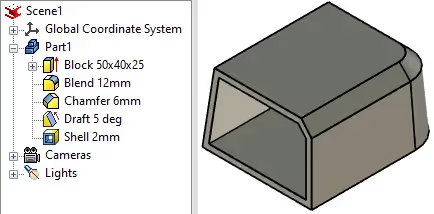
See some instructive videos on IronCAD Academy (English language).
IronCAD Academy about Blend Modification feature
IronCAD Academy about Chamfer Modification feature
IronCAD Academy about Draft Modification feature
IronCAD Academy about Shell Modification feature
IronCAD Academy about Trim Modification feature
It may be useful to know that you cannot move or copy a Modification feature with the TriBall. The TriBall only works together with Shape features. The reason is basically the same as how they are built. What you copy or move with the TriBall must be able to "stand on its own" and the result when copying or linking with the TriBall will never be associative to anything else, for better or worse.
For example, if you select one or more extrusions, you can activate the TriBall, but as soon as a Blend or Chamfer is also added to the active selection, you can no longer activate the TriBall. This is because the new Blend or Chamfer that would be "created" at the same time must first be associated ("linked") to an ID number of an edge or surface, but that edge/surface does not yet exist.

Therefore it is necessary to either create a new Blend afterwards or edit an existing Blend and add the new edges that have been created. Then consider the order in the history tree, where IRONCAD can automatically move an existing Blend to the end of the tree structure if necessary. If you have turned off this automatic function called "Part Reordering", you must first "manually drag" your Modification feature in the history tree to be placed after the new Shape features added last in the part.
Performance?
In most of the really heavy models (one-piece part) that we have seen over the years, it is consistently the case that a large number of Blend features are often behind slow regeneration times. This is often in combination with one or more Shell and Chamfer features, but the two often have a more "geometric function" where you need "a certain wall thickness" to move forward or that you need to "chamfer an edge a certain amount" to be able to do other things there.
In short, you could say that Shape features (Extrude, Spin... ) are quick to generate (except for a more advanced Loft with many planes!) and that Modification features (Blend, Chamfer, Shell etc) are slower to regenerate and the more the slower it gets.
By continuing to put your Blend features as usual in a model, right where they should be, but then directly suppressing (hiding) them - they are easily available when you need them, but they still do not weigh down the model unnecessarily.
Automatic Part or not?
Under Options, Part, there is a setting where you can choose between "automatic regeneration" of features or not. This means that with the default setting Regenerate Automatically, the smallest change in the model is always recalculated exactly when it occurs. E.g. if you draw a hole with TriBall, the first movement will regenerate the model, then the meter "lights up" and you enter exactly where the hole should be placed = another regeneration. This is usually not a problem in "regular" models. It takes a fraction of a second and you usually don't even have time to notice it.
By switching to the Wait to Regenereate until Deselected setting, nothing happens until the model is deselected. This is very useful for more complex models with lots of features and which take a longer time to calculate.
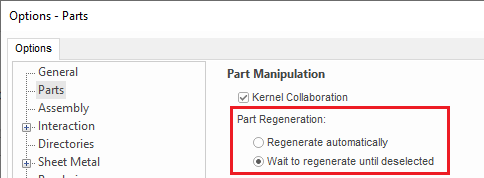
Allow Reordering
There is a patented technique in IRONCAD that automatically manages the order of features in the tree structure under a part. We recommend turning this feature off when the model becomes more complex and the exact order of all or some features is very important. This automatic feature can sometimes step in and move e.g. a Blend feature further down in the tree or a Shape feature to the top, because the technique is set to prevent certain conditions.
This setting can be accessed per part via right-click, under Interaction.

There is a very simple example of this where you move a hole to a position in the part where there is "no geometry" according to the history in the tree. Then the program will move the hole after the positive Shape feature in the order below the part in the tree.

(1) A positive extrusion in the form of a Block is added after the hole H Cylinder in the tree structure of the lot.
(2) The hole is moved with e.g. TriBall to a position in the party where it "cannot actually produce any effect", because there is no positive geometry at that position, according to the order in the tree. The block will therefore "eat up" the hole if one follows the order in the tree. As a user, I "see the geometry where I move the hole" and therefore still find it logical to move the hole to that position.
(3) Automatic reordering rearranges the order of the hole and moves it last below the party. The hole therefore removes material in the Block that is now at the top of the tree structure.
Without automatic reordering, I would therefore have had to move the hole in the tree myself, by dragging the icon after the block.
Since the TriBall does not create any features that have associations with edges/surfaces, it is good to know that there are alternative tools to the TriBall when it comes to creating linked patterns of features or if you want to mirror one or more features, which also creates an associative link between the original and the copy.
The tools for these are Pattern feature, Mirror feature and Scale Body and appear in the Transform group under the Ribbon tab. Feature. More on these below.

These features are based on a principle that in classic CAD language is called a "Parent-Child" relationship (the phrase "Master-Slave" is sometimes also used). The disadvantage of this principle is that there is no possibility to change the shape of individual "Children-features", you can only change their "Parent-feature", and they can only "exist" as long as their "Parent-feature" is also present. If it is removed or for some reason stops working, its "Children-features" will also stop working.
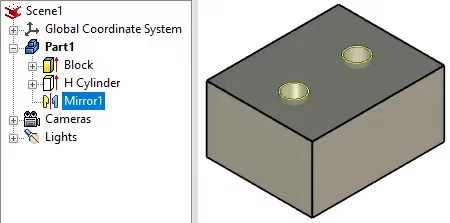
It is important to note that it would never happen that features created by the TriBall would disappear for the same reason, because no such "Parent-Child" relationship is ever created. Also, new features copied or linked via TriBall can never be associative to any other features. Linked features via TriBall are of course associative to each other in shape, but they are never (cannot be) associative in position to another edge or surface.
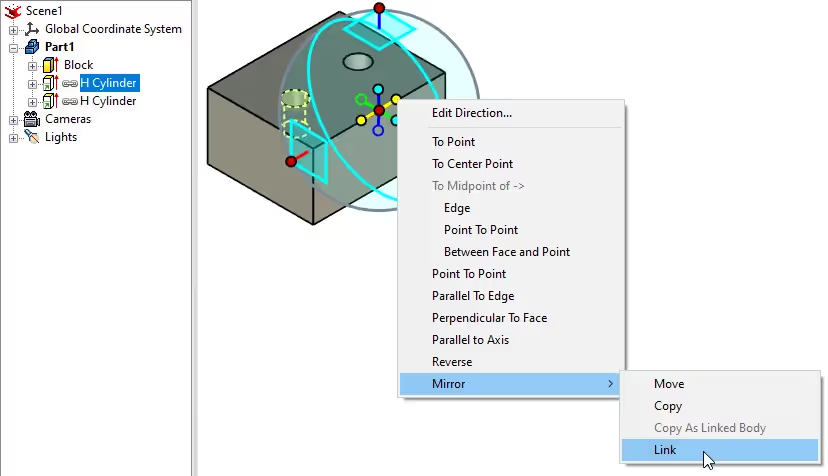
Instead, the position of a Shape feature is mainly controlled by the position of its Anchor Point in XYZ space (however, the Anchor Point can also be associated with a surface through a setting, a kind of "light constraint"). Another important difference is that "you can" change any of the linked copies created with TriBall, as there is no " Parent-Child" relationship. They are rather in a kind of"Equal-Twins" relationship.
Pattern Feature
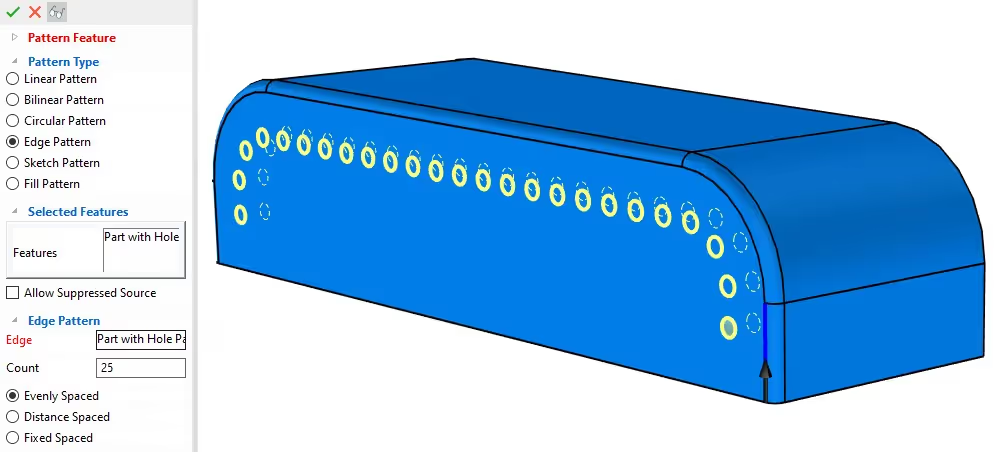
With Pattern feature you can create linear, circular, edge or point controlled patterns with features that follow selected points, an edge or an axis to rotate around. If the position or shape of the points, edge or axis changes, the pattern will be forced to adapt (associatively) to that change. It is not possible to create a similar function with the TriBall Pattern.
IronCAD Academy about Pattern feature
Mirror Feature

With Mirror feature you create a mirrored geometrically linked copy around an edge or axis that, in a similar way to a Pattern feature , is associative with the selected object. If the edge or axis is moved or otherwise changed, the mirrored copy is forced to adapt to the change. It is possible to mirror features also with TriBall Mirror, but the difference is that the mirrored copies with TriBall cannot get the same kind of associativity to other geometries.
IronCAD Academy about Mirror feature
Scale Body
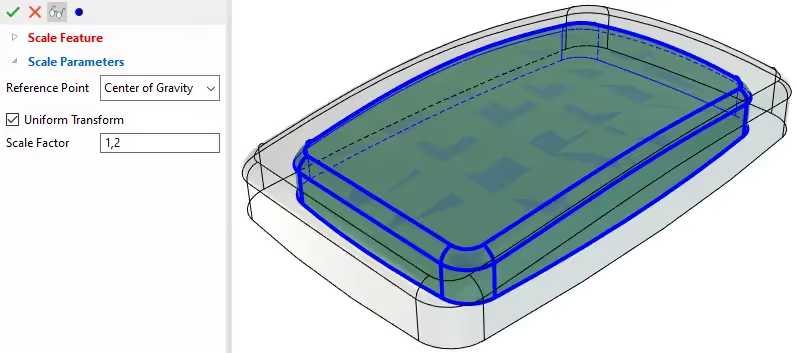
Med Scale Body allows you to scale up or down selected parts, or a Body in a Structured Part, by a certain scaling factor. If features in the part change their shape, the scaling effect will adjust the final result. Changing the scale of a shape can also be done with the Sizebox handles on a feature, it is even possible to bring up the Sizebox handles on a part or a assembly and thus change the scale on them as well!
Answer: Here we publish tips, guides, news and solutions for those who work with IRONCAD and Design Data Manager (DDM). The blog covers everything from basic functions to advanced workflows, helping you to optimize your design work. You'll find examples of smart shortcuts, practical instructions, solutions to common problems, and best practices for product design, mechanical design, and product data management.
Answer: Our guides and tips are designed for both beginners and experienced CAD users. They are aimed at designers, engineers and project managers who want to work more efficiently with IRONCAD and DDM, improve the design process, reduce mistakes and save time in product development.
Answer: We regularly publish new articles when the software is updated, when new features are introduced, or when our users ask for solutions to specific problems. The blog is therefore a reliable source for keeping up to date and getting tips that make everyday CAD work easier.
Answer: Many of our instructions and tips work in multiple versions, but we clearly indicate if an article applies to a specific version. We strive to make the content useful for older versions as well, and also provide recommendations on how to adapt workflows to the version you are using.
Answer: Absolutely! If you can't find the solution in the blog, you can contact our technical support via solidmakarna.support. Our experts will help you with everything from installation and configuration to advanced features in IRONCAD and DDM, so you can solve problems quickly and efficiently.
Answer: Yes! We appreciate suggestions from our users. If you have questions, tips or want us to address a specific issue in IRONCAD or DDM , please contact us via our contact form and we will prioritize relevant topics in future posts.
Answer: The blog contains, among other things:
Practical step-by-step guides to help you use IRONCAD and DDM more effectively.
Productivity and workflow tips for faster design and construction.
Solutions to common problems encountered by users in CAD programs.
Updates and news on new features, versions and improvements.
Best practices for data management and project organization in DDM.
Answer: All tips and guides are directly applicable in daily work. For example, you can use shortcuts and smart features in IRONCAD to speed up modeling, structure files better in Design Data Manager, or follow our step-by-step solutions for specific problems that often come up in design projects.
Answer: We strive to ensure that all guides and tips are relevant to the latest versions of IRONCAD and DDM. We also clearly mark when a post applies to an older version, so you always know if the instruction is directly applicable to your system.
Answer: Yes! Many of our users share the articles with colleagues and use them as internal training materials. The blog is a great complement to formal training and helps teams learn features faster, avoid mistakes, and standardize workflows in IRONCAD and DDM.